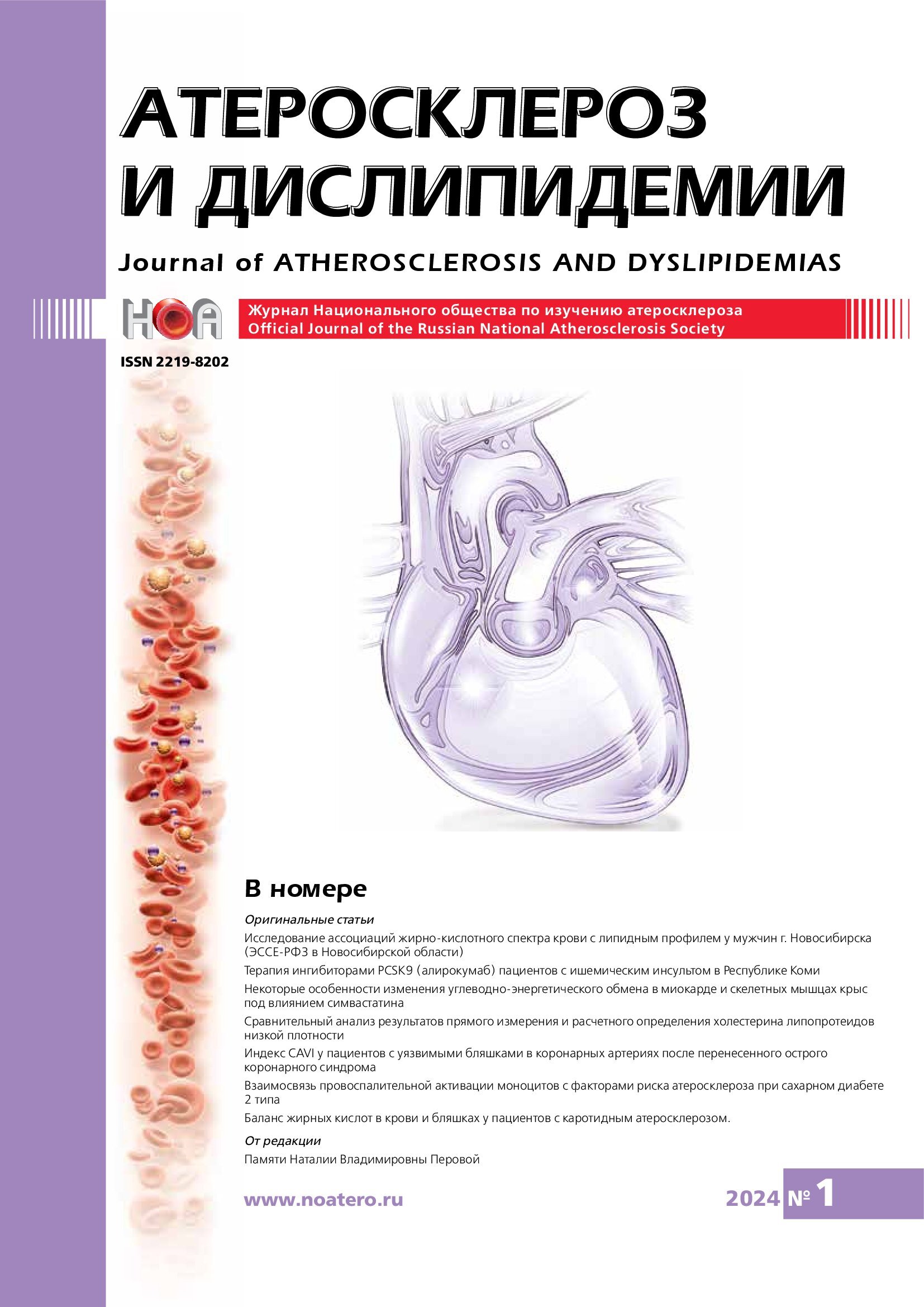CAVI index in patients with vulnerable plaques in the coronary arteries after acute coronary syndrome
DOI:
https://doi.org/10.34687/2219-8202.JAD.2024.01.0005Keywords:
CAVI index, arterial stiffness, vulnerable plaque, CCTAAbstract
The aim of the study: to study the relationship between the cardio-ankle index (CAVI) and multispiral computed tomography (CCTA) data of coronary arteries, as well as lipid profile indicators
in patients with acute coronary syndrome.
Materials and methods. In the period from September 2022 to March 2023, 96 patients aged 57.3 (55.4-59.1) years were examined, 67% of them men who were admitted in an emergency with the acute coronary syndrome (ACS) clinic at the V.P. Polyakov SRCCD. All patients underwent percutaneous coronary intervention of the infarct-related artery. Patients received ACS treatment
according to the recommendations, including statin therapy at the maximum dosage. At the 2nd visit, 1 month after ACS, coronary artery CCTA was performed, the CAVI index and lipid profile (TH, LDL, TG, HDL) were evaluated. The CAVI index was determined by the method of volumetric
sphygmography on the VaSera VS-Series Vascular device (Japan). СCTA was performed
on a 128-slice GE Revolution EVO. Vulnerable plaques were evaluated in the Plaque ID program according to the following criteria: positive remodeling, low-density non-calcified plaque (less than 30 HU), spotty calcification in the plaque, the phenomenon of napkin ring sign an uneven contour or a plaque rupture. The calcium index was calculated using the Agatson method.
Results. In the whole group, the value of R-CAVI was 9.3 (8,47-10,2), L-CAVI – 9.3 (8,2-10,3). In women, R-CAVI was 9.25 (8,7-9,93), L-CAVI – 9.25 (8,57-9,60), in men R-CAVI – 9.5 (8,4-10,4), L-CAVI – 9.3 (8,20-10.5). As a result of the correlation analysis, a highly reliable association of R-CAVI, L-CAVI with an increase in age was found (r=0.588, p <0.001 and r=0.619, p <0.001, respectively). The calcium index according to Agatson, calculated according to CCTA of coronary
arteries in the whole group, the calcium index was 58 (11-232) and positively correlated with the value of R-CAVI (r=0.318, p=0.002), L-CAVI (r=0.337, p <0.001). Negative correlations between the CAVI index and the level of low-density lipoprotein cholesterol (LDL-C) and triglycerides (TG) were also revealed. The relationship between the CAVI index and the presence of vulnerable plaques in the coronary arteries according to CCTA did not entail significant statistical significance (p=0.563).
Conclusion. Arterial stiffness is one of the therapeutic goals to reduce the overall burden of cardiovascular events. We have identified a relationship between the lipid spectrum and the CAVI index, but no correlation with the presence of unstable vulnerable plaques has been established.
Thus, the CAVI index cannot be used as a prognostic marker in the assessment of vulnerable coronary artery plaques.
Downloads
References
Miyoshi T, Ito H. Arterial stiffness in health and disease: The role of cardio-ankle vascular index. J Cardiol. 2021 Dec;78(6):493-501. doi: 10.1016/j.jjcc.2021.07.011. Epub 2021 Aug 12. PMID: 34393004.
Saiki A, Ohira M, Yamaguchi T, Nagayama D, Shimizu N, Shirai K, Tatsuno I. New Horizons of Arterial Stiffness Developed Using Cardio-Ankle Vascular Index (CAVI). J Atheroscler Thromb. 2020 Aug 1;27(8):732-748. doi: 10.5551/jat.RV17043. Epub 2020 Jun 26. PMID: 32595186; PMCID: PMC7458785.
Piotrowicz K, Gryglewska B, Grodzicki T, Gąsowski J. Arterial stiffness and frailty - A systematic review and metaanalysis. Exp Gerontol. 2021 Oct 1;153:111480. doi: 10.1016/j.exger.2021.111480. Epub 2021 Jul 12. PMID: 34265411.
Zairova A.R., Rogoza A. N., Oshchepkova E. V., Yarovaya E.B., Kutsenko V. A., Shalnova S. A., Trubacheva I. A., Kaveshnikov V.S., Serebryakova V. N., Boytsov S. A. Contribution of cardio-ankle vascular index to prediction of cardiovascular events in the adult urban population: data from the ESSE-RF study (Tomsk). Cardiovascular Therapy and Prevention. 2021;20(5):2967. (In Russ.) (Заирова А. Р., Рогоза А. Н., Ощепкова Е.В., Яровая Е.Б., Куценко В.А., Шальнова С.А., Трубачева И.А., Кавешников В.С., Серебрякова В.Н., Бойцов С.А. Значение показателя артериальной жесткости “сердечно-лодыжечный сосудистый индекс — CAVI” для прогноза сердечно-сосудистых событий в популяционной выборке взрослого городского населения (по материалам исследования ЭССЕ-РФ, Томск). Кардиоваскулярная терапия и профилактика. 2021;20(5):2967). doi:10.15829/1728-8800-2021-2967
Matsushita K, Ding N, Kim ED, Budoff M, Chirinos JA, Fernhall B, Hamburg NM, Kario K, Miyoshi T, Tanaka H, Townsend R. Cardio-ankle vascular index and cardiovascular disease: Systematic review and meta-analysis of prospective and cross-sectional studies. J Clin Hypertens (Greenwich). 2019 Jan;21(1):16-24. doi: 10.1111/jch.13425. Epub 2018 Nov 19. PMID: 30456903; PMCID: PMC8030558.
Namba T, Masaki N, Takase B, Adachi T. Arterial Stiffness Assessed by Cardio-Ankle Vascular Index. Int J Mol Sci. 2019 Jul 26;20(15):3664. doi: 10.3390/ijms20153664. PMID: 31357449; PMCID: PMC6695820.
Channon KM, Newby DE, Nicol ED, Deanfield J. Cardiovascular computed tomography imaging for coronary artery disease risk: plaque, flow and fat. Heart. 2022 Sep 12;108(19):1510-1515. doi: 10.1136/heartjnl-2021-320265. PMID: 35022211; PMCID: PMC9484394.
Trifonova SS, Gaisenok OV, Sidorenko BA. Application of methods of assessment of vascular stiffness in clinical practice: the possibility of cardio-ankle vascular index. Kardiologiia. 2015;55(4):61-6. (In Russ.) (Трифонова С. С., Гайсенок О.В., Сидоренко Б.А. Применение методов оценки жесткости сосудистой стенки в клинической практике: возможности сердечно-лодыжечного сосудистого индекса. Кардиология. 2015;55(4):61-6). doi:10.18565/cardio.2015.4.61-66.
Homma S, Kato K. Validity of Atherosclerotic Calcified Lesions Observed on Low-Dose Computed Tomography and Cardio-Ankle Vascular Index as Surrogate Markers of Atherosclerosis Progression. Angiology. 2023 Feb 14:33197231155963. doi: 10.1177/00033197231155963. Epub ahead of print. PMID: 36787785.]
Shimizu Y, Yamanashi H, Honda Y, Nonaka F, Miyata J, Kawashiri SY, Noguchi Y, Nakamichi S, Nagata Y, Maeda T. Low-Density Lipoprotein Cholesterol, Structural Atherosclerosis, and Functional Atherosclerosis in Older Japanese. Nutrients. 2022 Dec 30;15(1):183. doi: 10.3390/nu15010183. PMID: 36615839; PMCID: PMC9824696.
Sumin A.N., Shcheglova A.V.Assessment of Arterial Stiffness Using the Cardio-Ankle Vascular Index – What We Know and What We Strive for. Rational Pharmacotherapy in Cardiology 2021;17(4):619-627. (In Russ.) (Сумин А.Н., Щеглова А.В. Оценка артериальной жесткости с помощью сердечно-лодыжечного сосудистого индекса – что мы знаем, и к чему стремимся. Рациональная Фармакотерапия в Кардиологии 2021;17(4):619-627. DOI:10.20996/1819-6446-2021- 08-09). DOI:10.20996/1819-6446-2021-08-09.
Downloads
Published
How to Cite
Issue
Section
License
Copyright (c) 2024 А. Н. Ковальская, Г. Р. Бикбаева, А. П. Родин, П. Д. Дуплякова, В. А. Сальченко, Р. Р. Кудралеева, Г. Х. Таумова, Д. В. Дуплякова

This work is licensed under a Creative Commons Attribution 4.0 International License.























